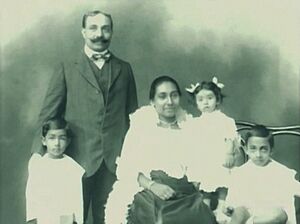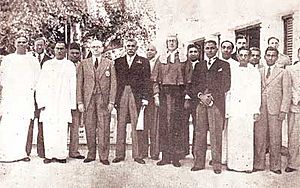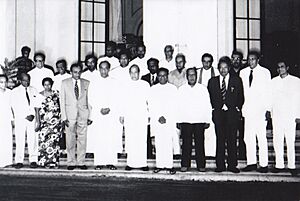J. R. Jayewardene facts for kids
Quick facts for kids
J. R. Jayewardene
|
|
|---|---|
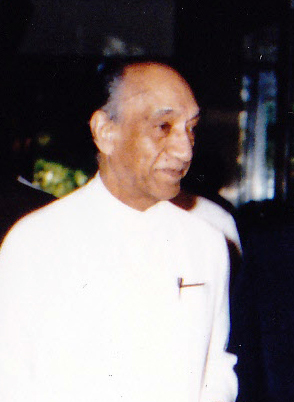 |
|
| 2nd President of Sri Lanka | |
| In office 4 February 1978 – 2 January 1989 |
|
| Prime Minister | Ranasingha Premadasa |
| Preceded by | William Gopallawa |
| Succeeded by | Ranasinghe Premadasa |
| 7th Prime Minister of Sri Lanka | |
| In office 23 July 1977 – 4 February 1978 |
|
| President | William Gopallawa |
| Preceded by | Sirimavo Ratwatte Dias Bandaranaike |
| Succeeded by | Ranasinghe Premadasa |
| 6th Leader of the Opposition | |
| In office 7 June 1970 – 18 May 1977 |
|
| Prime Minister | Sirimavo Bandaranaike |
| Preceded by | Sirimavo Bandaranaike |
| Succeeded by | A. Amirthalingam |
| 6th Secretary General of Non-Aligned Movement | |
| In office 4 February 1978 – 9 September 1979 |
|
| Preceded by | William Gopallawa |
| Succeeded by | Fidel Castro |
| Minister of Finance | |
| In office 24 April 1960 – 20 July 1960 |
|
| Prime Minister | Dudley Senanayake |
| Preceded by | Oliver Ernest Goonetilleke |
| Succeeded by | Stanley de Zoysa |
| In office 26 September 1947 – 13 October 1953 |
|
| Prime Minister | Don Stephen Senanayake Dudley Senanayake |
| Succeeded by | Oliver Ernest Goonetilleke |
| Member of Parliament for Colombo West |
|
| In office 4 August 1977 – 4 February 1978 |
|
| Preceded by | Constituency created |
| Succeeded by | Anura Bastian |
| Member of Parliament for Colombo South |
|
| In office 5 August 1960 – 18 May 1977 |
|
| Preceded by | Edmund Samarawickrema |
| Succeeded by | Constituency abolished |
| Member of the Ceylon Parliament for Kelaniya |
|
| In office 30 March 1960 – 23 April 1960 |
|
| Preceded by | R.G. Senanayake |
| Succeeded by | R.S. Perera |
| In office 14 October 1947 – 18 February 1956 |
|
| Preceded by | Constituency created |
| Succeeded by | R.G. Senanayake |
| Personal details | |
| Born |
Junius Richard Jayewardene
17 September 1906 Colombo, British Ceylon |
| Died | 1 November 1996 (aged 90) Colombo, Sri Lanka |
| Nationality | Sri Lankan |
| Political party | United National Party |
| Spouses | Elina Jayewardene (1935–1996) |
| Children | Ravi Jayewardene (Son) |
| Parents |
|
| Residence | Braemar |
| Alma mater | Colombo Law College, University College, Colombo, Royal College, Colombo, Bishop's College Colombo |
| Profession | Advocate |
| Signature | |
Junius Richard Jayewardene (Sinhala: ජුනියස් රිචඩ් ජයවර්ධන, Tamil: ஜூனியஸ் ரிச்சட் ஜயவர்தனா; 17 September 1906 – 1 November 1996), often called J.R. in Sri Lanka, was a very important leader in Sri Lanka. He led the country from 1977 to 1989. First, he was the Prime Minister from 1977 to 1978. Then, he became the second President of Sri Lanka from 1978 to 1989.
J.R. Jayewardene was a key figure in Sri Lanka's journey to independence. He held many important government jobs after the country became independent. He was a long-time member of the United National Party. In 1977, he led his party to a huge win. He then became Prime Minister and later the country's first executive president.
He is a well-known figure in the history of Sri Lanka. He introduced an "open economy" in 1978. This helped Sri Lanka's economy grow after a difficult period. However, some of his actions, especially during the Black July riots of 1983, are seen as contributing to the start of the Sri Lankan Civil War.
Contents
Early Life and Education
Childhood and Family
Junius Richard Jayewardene was born in Colombo, British Ceylon (now Sri Lanka). His family was well-known and many of them were lawyers. He was the oldest of twelve children. His father, Eugene Wilfred Jayewardene, was a famous lawyer. His mother was Agnes Helen Wijewardena. His family called him Dickie. He had an English nanny and went to Bishop's College, Colombo for his first schooling.
School and University
J.R. Jayewardene later attended Royal College, Colombo. He was excellent at sports there. He played for the cricket team and captained the rugby team. He was also vice-captain of the football team. He won awards in boxing and was a senior cadet. He was also the editor of the college magazine and the head prefect in 1925.
After school, he studied law at University College, Colombo and Ceylon Law College. He won several awards for his studies. In 1931, he became a lawyer.
Marriage and Home
On 28 February 1935, J.R. Jayewardene married Elina Bandara Rupasinghe. She came from a wealthy family. They had one son, Ravindra "Ravi" Vimal Jayewardene. The family first lived in his parents' house. Later, they moved to their own home, Braemar, in 1938. They lived there for the rest of their lives.
Beginning of Political Career
J.R. Jayewardene became interested in politics when he was a student. He strongly believed in nationalism, which means loving and supporting your own country. He changed his religion from Anglicanism to Buddhism. He also started wearing the national dress as his formal clothing.
He did not work as a lawyer for long. In 1943, he became active in the Ceylon National Congress (CNC). This group was important for Ceylon's independence movement. He became a joint secretary of the CNC in 1939. In 1940, he was elected to the Colombo Municipal Council.
In the State Council
In 1943, he was elected to the State Council, which was the colonial legislature. He won the election for the Kelaniya Electoral District. During World War II, Jayewardene and other nationalists talked with the Japanese. They discussed how to gain independence from the British. In 1944, Jayewardene suggested that Sinhala should become the official language instead of English.
First Finance Minister
After Sri Lanka gained independence, J.R. Jayewardene joined the United National Party in 1946. He was re-elected from Kelaniya in the 1947 election. D. S. Senanayake appointed him as the first Minister of Finance in 1947. He helped set up the Central Bank of Ceylon.
In 1951, he was part of the committee that chose Sri Lanka's National Anthem. The next year, he became the President of the Board of Control for Cricket in Ceylon. He also played a big role in helping Japan rejoin the world community after World War II. He worked hard to manage the country's money, especially with high costs for rice subsidies. He was re-elected in 1952 and stayed as finance minister.
In 1953, he suggested cutting subsidies for rice. This caused strong protests, known as the 1953 Hartal. The plan had to be stopped. After this, Prime Minister Dudley Senanayake resigned. The new Prime Minister, Sir John Kotelawala, made Jayewardene the Minister of Agriculture and Food. He also became the Leader of the House.
Defeat and Opposition
In the 1956 election, the United National Party lost badly to a group led by S. W. R. D. Bandaranaike. J.R. Jayewardene even lost his own seat in parliament.
After losing his seat, Jayewardene encouraged his party to support the Sinhala Only Act. This act made Sinhala the only official language. Many minority groups on the island were against this. When Bandaranaike tried to make an agreement to solve problems for minorities, Jayewardene led a protest march. He also supported the party's newspaper, which published articles against Tamils.
Throughout the 1960s, Jayewardene and party leader Dudley Senanayake disagreed on this issue. Jayewardene believed the party should focus on the concerns of the majority ethnic group.
Return to Government
In March 1960, the United National Party won a small victory. J.R. Jayewardene was elected to parliament again from Kelaniya. He was once more appointed as Minister of Finance. However, this government only lasted three months. In July 1960, they lost the election. Jayewardene remained in parliament as an opposition member, representing the Colombo South electorate.
The United National Party won the next election in 1965. They formed a government with another party. Jayewardene was re-elected without opposition from Colombo South. He became the Chief Government Whip. Prime Minister Senanayake also made him Minister of State. This meant he was almost like a deputy prime minister.
J.R. Jayewardene focused on developing the tourism industry. He saw tourism as a great way to earn money for the country. It could also create many jobs. He helped create laws to support the tourism industry. Today, tourism in Sri Lanka is a major industry.
Leader of the Opposition
In the 1970 general election, the UNP lost badly. J.R. Jayewardene became the leader of the opposition. He also became the leader of the UNP because Dudley Senanayake was ill. After Senanayake's death in 1973, Jayewardene officially became the UNP leader.
He supported the government during the 1971 JVP Insurrection. He also supported the new constitution in 1972, which made Ceylon a republic. However, he disagreed with many government decisions. He thought their "closed economy" policies and taking over private businesses would harm the country. In 1976, he resigned from parliament in protest. He did this because the government extended its term without holding an election.
Becoming Prime Minister
People were becoming very unhappy with the government. J.R. Jayewardene led the UNP to a massive victory in the 1977 election. The UNP won a huge number of seats in parliament. Jayewardene was elected from the Colombo West Electoral District. He became Prime Minister and formed a new government.
Presidency
Soon after becoming Prime Minister, he changed the constitution. This made the presidency a powerful executive role. Because of this change, he automatically became president on 4 February 1978. He introduced a new constitution on 31 August 1978. This new constitution gave the president very strong powers. He also moved the legislative capital from Colombo to Sri Jayawardanapura Kotte.
He also made changes that affected political opponents. For example, he took away the civic rights of Sirimavo Bandaranaike. This stopped her from running for office for six years. This made it easier for him to win the 1982 election. He also held a public vote to allow the 1977 parliament to continue until 1989. He also passed a law that removed any Member of Parliament who supported separatism. This affected the main opposition party, the Tamil United Liberation Front.
Economy Under J.R. Jayewardene
J.R. Jayewardene completely changed Sri Lanka's economic policy. The old policies had caused the economy to slow down. He opened the economy to market forces. This means he allowed more private businesses and foreign investment. Many people believe this led to strong economic growth.
He encouraged foreign and local businesses to invest in Sri Lanka. This helped the country export more goods. He also set up the Greater Colombo Economic Commission to help with export zones. He reduced food subsidies but gave food stamps to poor families. He also started new welfare programs, like free school books and scholarships.
He also started big building projects. He launched a large housing program. The Accelerated Mahaweli Programme built new dams and hydropower projects. These included the Kotmale, Victoria, and Randenigala dams. These projects helped bring water to dry areas.
Protecting Nature
His government also started several projects to protect wildlife. They stopped commercial logging in rain forests like Sinharaja Forest Reserve. This forest was made a World Biosphere Reserve in 1978 and a World Heritage Site in 1988.
Tamil Militancy and Civil War
J.R. Jayewardene tried to stop the growing activity of Tamil militant groups. These groups had been active since the mid-1970s. In 1979, he passed the Prevention of Terrorism Act. This law gave police strong powers to arrest and hold people. However, this only made ethnic tensions worse.
After the 1977 riots, the government made one change for the Tamils. They removed a policy that made it harder for Tamil youth to get into university. But militant groups felt this was not enough. Violent attacks continued. This led to the Black July riots in 1983. These riots turned the militancy into a civil war. More people joined the militant groups.
By 1987, the LTTE became the strongest Tamil militant group. They controlled the Jaffna Peninsula. Jayewardene's government started a big military operation to defeat the LTTE. However, he had to stop the attack because India put pressure on him. India wanted a peaceful solution.
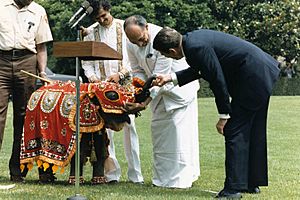
Jayewardene and Indian Prime Minister Rajiv Gandhi signed the Indo-Sri Lanka Accord. This agreement aimed to give more power to Tamil areas. It also brought an Indian peacekeeping force to the north. However, the LTTE rejected the agreement. They felt it did not give enough power to Tamil areas.
Many Sinhalese nationalists were also angry about the agreement. They did not like the idea of giving power to Tamil regions or having foreign troops in Sri Lanka. In 1987, there was an attempt to harm Jayewardene because he signed the accord. Young Sinhalese people also started a revolt, led by the Janatha Vimukthi Peramuna (JVP). The government stopped this revolt by 1989.
Foreign Policy
J.R. Jayewardene's foreign policy was different from the previous leader. He made Sri Lanka's policies more aligned with American policies. This was sometimes called 'Yankie Dickie'. This caused some disagreements with neighboring India.
After Presidency
J.R. Jayewardene left politics in 1989 after his second term as president. He was 82 years old. His successor, Ranasinghe Premadasa, became president on 2 January 1989. Jayewardene did not return to politics after he retired.
Death
J.R. Jayewardene passed away from colon cancer on 1 November 1996. He was 90 years old. He died at a hospital in Colombo. His wife, Elina, and his son, Ravi, survived him.
Legacy and Impact
Many people believe J.R. Jayewardene's economic policies were very good for Sri Lanka. He is often credited with saving the country's economy. For 30 years after independence, Sri Lanka had slow growth and high unemployment. By opening the country to foreign investments and promoting private businesses, he helped the island grow well, even during the civil war. A writer from The New York Times said that his policies changed the economy from one of scarcity to one of abundance.
However, his actions regarding ethnic tensions are seen differently. When he became president, ethnic tensions were present but not as severe. During his time, relations between the Sinhalese and Tamils became much worse. His response to these tensions has been criticized. Jayewardene once said that the differences between Sinhalese and Tamils were "an unbridgeable gap."
He is highly respected in Japan. This is because he called for peace and reconciliation with post-war Japan at the Peace Conference in San Francisco in 1951. A statue of Jayewardene was built in his honor at the Kamakura Temple in Japan.
J.R. Jayewardene Centre
In 1988, the J.R. Jayewardene Centre was created by a special law. It is located at J.R. Jayewardene's childhood home in Colombo. This center keeps his personal library and papers. It also stores records from the Presidential Secretariat and gifts he received as president.
See also
 In Spanish: J. R. Jayewardene para niños
In Spanish: J. R. Jayewardene para niños
- Jayewardene cabinet
- Braemar, Colombo
- Vaijantha
- List of political families in Sri Lanka
- 1987 grenade attack in the Sri Lankan Parliament
Images for kids


